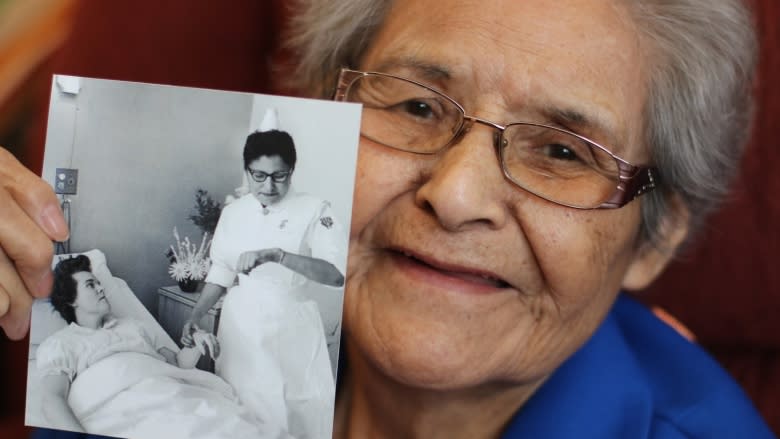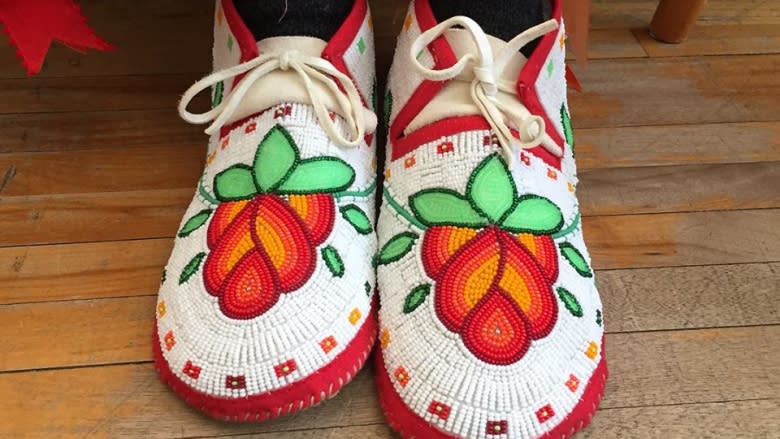From residential school to one of Manitoba's 1st Indigenous nurses
One day, four-year-old Ann Thomas Callahan was told to get ready. She put on a dress, and was proud to wear it. Her father packed a lunch and together they travelled to the File Hills Indian Residential School near Balcarres, Sask., by horse and wagon.
She was excited about the prospect of being able to see her sister, who was already at the school, but on the ride through the bush, she noticed that her father was unusually quiet.
When they got to the school, her father held her hand and walked her up to the veranda as other children were arriving at the school. When they reached the steps, he handed her off to her cousin and asked her to keep Ann calm.
As he walked away from her, that's when it sunk in — her father was leaving her there.
He whipped the horses to speed up as Callahan chased after the wagon down the gravel road. She managed to catch up to him and that's when he stopped.
"He picked me up and said, 'I can't take you with me, my girl.'"
Callahan asked her father why she couldn't go back home.
"He said, 'We'll go to jail. We can't keep you children at home. You've got to stay here.'"
It was the first time she saw her father cry.
Callahan went on to spend 14 years in residential schools. She opted to pursue more education and became one of the first First Nations nurses in Manitoba.
Life with her family
Before residential school, life was simple for her family in Peepeekisis First Nation. Her parents were successful farmers.
Her mother and father, Nora Keewatin and John Thomas, had previous marriages but their spouses had died. Her parents were encouraged by an Indian agent to remarry, so they could continue farming.
Indian agents were non-Indigenous administrators who held a considerable amount of decision making powers over First Nations reserves and people.
In her own words, she wasn't supposed to be born. Her mother was 50 years old when she gave birth to her in 1935, and Callahan likes to joke that they thought she was a tumour.
She was the youngest child from both families and described her mother as the leader of her family.
"Mom was the matriarch, she was the boss. Dad stayed on the sidelines. Mom was more strict with us, because she had more time with us."
She remembers the community as "rich and loving" and her parents as kind.
She remembers her parents taking her to pick saskatoon berries when she was four. She remembers them speaking the Cree language to each other and placing her down near a saskatoon bush, allowing her to fill her stomach. As she was eating, she heard them look at each other and say "Isn't she beautiful?"
"I thought to myself, that was so wonderful. I knew I was loved," said Callahan.
Not long after that, the Indian agent informed Thomas that he would have to send the baby of his family to residential school, so that he could continue farming.
At the residential school
To cope with the pain of being left at the school, Callahan told herself that other children were feeling the same loneliness.
"As little kids, young ones, we would cry in our pillows at night, we were so lonesome," she said.
At the start of one school year in August, she heard the whimpers of a young boy crying at night. He cried every night until one night in October, and she recalls his body being taken out of the residential school the next morning. She thinks he was ill but doesn't recall him receiving any medical treatment.
The boy's name was "Little Ronny." She found out later on that there were no records kept of Little Ronny's death.
She remembers finding comfort at night by sneaking into her sister's bed, only to be found by the dormitory's supervisors and punished with a strap to the backside for leaving her own bed.
"We were punished for trivial things. You step out of line and you were cuffed on your ears."
The food provided was scarce, the clothing scarce. She remembers staring out the windows during school hours and feeling depressed.
"I always promised myself at the residential school — I'd lie on the playground and look at the fluffy clouds and say 'Someday I'm going to own my own house," she said.
She spent 10 years at File Hills. The school was torn down in 1946 ("What a happy day! We were so happy"), and Callahan went back home to Peepeekisis First Nation where she attended day school for one year.
The teacher who inspired her
That one year of day school was life-changing, she said. It was there that she met a new teacher who had just graduated from university.
Miss Eggensweiller taught them good grooming, biology and possessed an "expansive ideology." Callahan remembers her day school experience as being the complete opposite of residential school.
"It's like she really cared for us," she said.
When the report cards from day school came out, she showed them to her father.
"Are these your grades?" her father asked her.
He was surprised that she was doing so well in school and asked her what she wanted to do. She said that she wanted to keep on going to school, which meant that she would have to leave the province.
"There was no high school for us Indian kids in Saskatchewan," Callahan said.
Her father encouraged her to talk to her sister-in-law, who was a war bride from Scotland, about nursing.
After talking with her, Callahan was convinced. She wanted to pursue nursing, but that meant attending high school at the Birtle Indian Residential School in Manitoba.
Her father died when she was in Grade 10, but he had instilled confidence in his daughter that she would finish her education.
Off to nursing school
In 1954 she graduated high school at Birtle. Immediately after graduation, she went into the nursing program at Winnipeg General Hospital.
For Callahan, going from residential school to a nursing program was a scary experience. The quality of the education that she was getting at residential school wasn't up to par with her non-Indigenous classmates and she had to work twice as hard to catch up academically. She worked hard to conquer her science classes, but patients told her she was gifted with a warm bedside manner.
During summer break from the nursing program, she went to work as a nurse's aide at a tuberculosis sanatorium in Fort Qu'appelle, Sask.
It was there that she got her first taste of discrimination in a professional environment. She remembers the kitchen staff trying to bully her.
They would say things like "Dirty Indian, go back to your teepee," she said.
She didn't report it to her supervisors because she "didn't want to make trouble."
Throughout her nursing career, she was challenged with racism, but described it as being subtle.
Dream fulfilled
Callahan graduated from the nursing program in 1958 and began her career at Winnipeg General Hospital, working in the gynecology ward, and became head nurse.
"If I saw Aboriginal people, I would sidle up to them, because I knew they were scared. I would sit beside them and let them talk because many of them didn't speak English."
She was instrumental in getting Indigenous interpreters at the hospital, and advocated for Indigenous patients.
In 1973 she left the hospital for a position with a health organization serving mostly Indigenous people in downtown Winnipeg.
She volunteered on many different projects outside of nursing, and went on to become a nursing instructor at Red River College in 1983, retiring in 1996.
After her retirement, she attended university and earned a bachelor's and a master's degree.
Her efforts have been recognized and awarded by both the Indigenous and non-Indigenous community.
In 2007, the Winnipeg Health Sciences Centre named a building after her to honour her commitment to the health care sector in Manitoba.
But out of all her accomplishments, the one that she is most proud of was the ability to earn her own money, enabling her to fulfil the dream she had in the playground at residential school.
Callahan bought her own house in Winnipeg in 1973, and still lives there today. She said that's something that her parents would be proud of.
This story is part of our project Beyond 94: Truth and Reconciliation in Canada that launches March 19. Read more stories in the series and look for further coverage this week.



